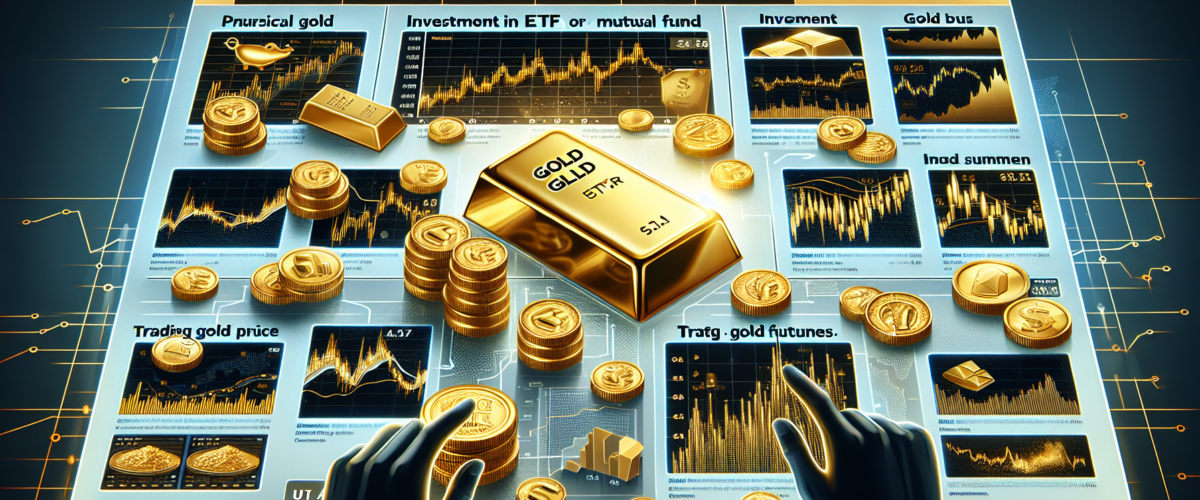So, you’ve decided to dip your toes into the world of investing in gold, but you’re not quite sure where to start. With its historical significance and reputation for being a safe haven investment, gold has long been a popular choice for investors. However, for a beginner like yourself, it can feel overwhelming trying to navigate the various options available. Should you buy physical gold, invest in gold stocks, or consider gold ETFs? In this article, we’ll explore the different avenues for investing in gold and help you find the best approach for your beginner’s portfolio.

Understanding the Basics of Investing in Gold
Gold has long been recognized as a valuable and precious commodity. It has been used as a form of currency and a symbol of wealth for centuries. In recent years, gold has gained popularity as an investment option due to its ability to act as a hedge against inflation and uncertainty in the financial markets. Whether you are a seasoned investor or just starting out, understanding the basics of investing in gold is crucial to making informed investment decisions.
What is gold and why is it a popular investment?
Gold is a naturally occurring element that is highly valued for its luster and scarcity. It is often associated with luxury and wealth. The demand for gold stems from its various uses, including jewelry, technology, and central bank reserves. As an investment, gold is popular for several reasons. Firstly, it is considered a safe-haven asset that tends to hold its value during economic downturns. Secondly, gold has historically demonstrated a low correlation with other asset classes, making it an effective diversification tool. Lastly, gold has the potential for long-term capital appreciation, especially during times of inflation or geopolitical uncertainty.
Factors to consider before investing in gold
Before jumping into the world of gold investing, there are several factors to consider. Firstly, it is important to determine your investment objective. Are you looking to preserve wealth, generate income, or speculate on price movements? This will dictate the type of gold investment you should consider. Next, assess your risk tolerance. Gold can be a volatile asset, and its price can experience significant fluctuations. Understanding how much risk you are willing to take on will help guide your investment decisions. Finally, consider your overall portfolio diversification. Gold should be viewed as a component of a well-balanced investment portfolio, rather than the sole focus of your investments.
Different forms of investing in gold
Investing in gold can be done through various methods, each with its own advantages and considerations. The main forms of investing in gold include buying physical gold, investing in gold ETFs (Exchange-Traded Funds), purchasing gold mining stocks, and investing in gold futures and options. Each of these methods has its own unique characteristics, risk profiles, and potential returns. It is important to understand the different forms of investing in gold to determine which one aligns with your investment objectives and risk tolerance.
Determining the Investment Objective
Before diving into the world of gold investing, it is crucial to determine your investment objectives. By identifying your goals, you can ensure that your investment strategy aligns with your financial aspirations and time horizon.
Identifying short-term or long-term goals
One of the first steps in determining your investment objective is to identify whether you have short-term or long-term goals. Short-term goals can include saving for a down payment on a house or funding a vacation, while long-term goals may involve retirement savings or purchasing property. Understanding the timeframe of your investment goals will help guide your decision-making process.
Considering risk tolerance
Another important factor to consider is your risk tolerance. This refers to the amount of risk you are willing and able to take on in your investments. Gold can be a volatile asset, with its price fluctuating based on various factors such as economic conditions, geopolitical events, and market sentiment. Assessing your risk tolerance will help determine the level of volatility you can handle in your investment portfolio.
Understanding portfolio diversification
Lastly, it is crucial to understand the concept of portfolio diversification. This entails spreading your investments across different asset classes to reduce risk and potentially enhance returns. Gold can play a role in diversifying your portfolio, as it has historically shown a low correlation with other asset classes such as stocks and bonds. By including gold in your investment mix, you can potentially reduce the overall risk of your portfolio and enhance its overall performance.
Researching and Analyzing the Gold Market
Once you have determined your investment objectives, it is important to conduct thorough research and analysis of the gold market. This will help you make informed investment decisions and maximize the potential returns on your investment.
Studying the factors influencing gold prices
The price of gold is influenced by a range of factors, including economic conditions, geopolitical events, interest rates, and inflation. It is important to stay informed about these factors and their potential impact on the price of gold. For example, during times of economic uncertainty, the demand for gold as a safe-haven asset tends to increase, leading to higher prices. Understanding these factors and their interplay can help you anticipate potential price movements and make better investment decisions.
Analyzing supply and demand dynamics
The supply and demand dynamics of the gold market play a crucial role in determining its price. Gold is a finite resource, with mining production and central bank selling being the primary sources of supply. On the other hand, jewelry demand, investment demand, and industrial usage contribute to the overall demand for gold. By analyzing the supply and demand dynamics, you can gain insights into the future direction of gold prices. Factors such as increasing demand from emerging markets or declining production levels can impact the supply-demand balance and subsequently influence gold prices.
Keeping track of market trends
Staying informed about market trends is essential when investing in gold. This involves monitoring news and market developments that may impact the price of gold. Market trends can provide valuable insights into the sentiment and behavior of investors, which can impact the short-term and long-term price movements of gold. By keeping a close eye on market trends, you can potentially identify investment opportunities and time your gold purchases or sales more effectively.
Choosing the Right Method of Investing
With an understanding of the gold market and your investment objectives, it is now time to choose the right method of investing in gold. There are several options available, each with its own set of advantages and considerations.
Buying physical gold
Buying physical gold in the form of bars, coins, or jewelry is perhaps the most traditional method of investing in gold. Physical gold provides tangible ownership and allows for immediate possession. However, it also comes with associated costs such as storage and insurance. Additionally, buying physical gold requires careful consideration of purity, authenticity, and verification. While physical gold offers a sense of security, it may also require more active management and attention compared to other methods of investing in gold.
Investing in gold ETFs (Exchange-Traded Funds)
Gold ETFs have gained popularity in recent years as a convenient and cost-effective way to gain exposure to the price of gold. Gold ETFs are investment funds that track the price of gold and are traded on stock exchanges. They offer the benefits of diversification, liquidity, and ease of trading. Investing in gold ETFs allows you to indirectly own gold without the need for physical storage or handling. However, it is important to evaluate the expense ratios and liquidity of the ETFs, as well as the impact of management fees on your returns.
Purchasing gold mining stocks
Investing in gold mining stocks involves purchasing shares of companies involved in the exploration, development, and production of gold. This method allows you to gain exposure to the potential profits and growth of these companies. However, investing in gold mining stocks comes with its own set of considerations. Researching and analyzing individual companies’ financials, management expertise, geopolitical risks, and operational factors is crucial. This method requires more active management and a thorough understanding of the mining industry.
Investing in gold futures and options
Gold futures and options are derivative instruments that allow investors to speculate on the future price of gold without owning the physical metal. These financial instruments offer the potential for leverage and can be used for short-term trading or hedging purposes. However, investing in gold futures and options requires a good understanding of these complex instruments and the associated risks. Investors should carefully consider leverage, margin requirements, and the potential for losses when trading derivatives.

Investing in Physical Gold
Investing in physical gold in the form of bars, coins, or jewelry provides a sense of ownership and security. However, it is important to understand the various forms of physical gold and consider the associated costs and premiums.
Understanding various forms of physical gold
When investing in physical gold, you have several options to choose from. Gold bars, also known as bullion bars, are available in various sizes and weights. They are produced by refineries and have a high gold content. Another option is gold coins, which are minted by government or private mints. Gold coins often have a face value and may carry numismatic value in addition to their gold content. Lastly, gold jewelry provides an aesthetically appealing form of physical gold. However, it is important to note that jewelry often carries additional costs due to craftsmanship and design.
Choosing between gold bars, coins, or jewelry
The choice between gold bars, coins, or jewelry depends on various factors, including personal preference, investment goals, and liquidity considerations. Gold bars are often preferred by institutional investors and those looking for maximum gold content and purity. Gold coins can be more accessible to individual investors and may offer the added benefit of aesthetic value. Gold jewelry, while offering the allure of wearing gold, may not be the most cost-effective investment due to the additional costs associated with design and craftsmanship. It is important to carefully consider your investment objectives and evaluate the suitability of each form of physical gold.
Determining appropriate storage options
One crucial aspect of investing in physical gold is determining appropriate storage options. Physical gold needs to be stored securely and protected from theft, damage, or loss. The storage options include home safes, bank safety deposit boxes, or third-party storage facilities. Each option has its own advantages and considerations. While storing gold at home provides immediate access, it may come with higher security risks. Bank safety deposit boxes offer enhanced security but may have restrictions on access. Third-party storage facilities provide professional storage services but may incur additional costs. It is important to weigh the pros and cons of each storage option and choose the one that suits your requirements and budget.
Considering costs and premiums
When investing in physical gold, it is crucial to consider the costs and premiums associated with different forms of gold. Gold bars and coins often carry a premium above the spot price of gold due to production costs and supply-demand dynamics. Additionally, there may be costs associated with verifying the authenticity and purity of the gold. Gold jewelry, in addition to the cost associated with gold content, carries premiums related to craftsmanship and design. It is important to carefully evaluate the costs and premiums associated with each form of physical gold and consider their impact on your overall investment returns.
Investing in Gold ETFs
Gold ETFs have emerged as a popular investment option for those looking to gain exposure to the price of gold without the need for physical ownership. Understanding how gold ETFs work and evaluating their key characteristics is crucial when considering this investment method.
Understanding how gold ETFs work
Gold ETFs are investment funds that aim to track the price of gold. They are traded on stock exchanges, making them easily accessible to individual investors. Gold ETFs hold physical gold as their underlying asset and issue shares representing fractional ownership. As the price of gold fluctuates, the value of the ETF shares also changes. By investing in gold ETFs, investors can gain exposure to the price of gold without the need for physical storage or handling.
Evaluating expense ratios and liquidity
When considering gold ETFs, it is important to evaluate the expense ratios and liquidity of the funds. Expense ratios refer to the annual fees charged by the ETF providers for managing the fund. Lower expense ratios can have a positive impact on the overall returns of the investment. Liquidity refers to the ease of buying and selling the ETF shares. Higher liquidity ensures that there is a ready market for the shares, allowing investors to easily enter or exit their positions. Assessing the expense ratios and liquidity levels of gold ETFs is crucial in making an informed investment decision.
Considering the impact of management fees
In addition to expense ratios, it is important to consider the impact of management fees when investing in gold ETFs. Management fees are charged by the ETF providers for the services rendered in managing the fund. These fees can vary across different ETFs and can impact the overall returns of the investment. By carefully evaluating the management fees, investors can ensure that they are getting value for their investment and minimize the impact of fees on their returns.
Tracking the performance of the underlying index
Gold ETFs aim to track the performance of the underlying index, which represents the price of gold. It is important to understand the tracking mechanism and ensure that the ETF accurately reflects the price movements of gold. Tracking errors can occur due to factors such as management fees, operational costs, or market conditions. By monitoring the performance of the gold ETF and comparing it to the price of gold, investors can assess the effectiveness of the tracking mechanism and make necessary adjustments to their investment strategy if required.

Investing in Gold Mining Stocks
Investing in gold mining stocks allows investors to gain exposure to the potential profits and growth of companies involved in the exploration and production of gold. However, careful research and analysis are crucial to making informed investment decisions in this sector.
Researching and analyzing gold mining companies
When investing in gold mining stocks, it is crucial to research and analyze the companies in which you plan to invest. This involves reviewing their financial statements, annual reports, and investor presentations. By understanding the company’s financial health, growth prospects, and competitive advantages, you can assess its potential for generating profits and creating shareholder value. Additionally, researching the management team’s expertise and track record can provide insights into their ability to navigate the challenges of the mining industry.
Assessing management expertise and financials
The expertise and track record of the management team are important considerations when investing in gold mining stocks. Experienced and capable management teams can effectively steer the company through operational challenges, market fluctuations, and regulatory changes. It is important to evaluate the management team’s track record, industry experience, and their ability to execute the company’s strategic vision. Additionally, a thorough analysis of the company’s financials, including cash flow, debt levels, and profitability, can provide insights into its financial health and ability to weather market downturns.
Understanding geopolitical and operational risks
Investing in gold mining stocks comes with its own set of risks, including geopolitical and operational risks. Geopolitical risks refer to factors such as changes in government regulations, political instability, and resource nationalism, which can impact the profitability of mining operations. Operational risks include challenges related to exploration, production, and environmental considerations. By understanding and assessing these risks, investors can make informed decisions and manage their exposure to potential downside risks.
Monitoring production and exploration activities
When investing in gold mining stocks, it is important to monitor the company’s production and exploration activities. Production levels and costs directly impact the company’s profitability and ability to generate returns for shareholders. Monitoring the company’s gold production levels, reserve estimates, and production costs can provide insights into its operational efficiency and potential for growth. Additionally, staying informed about the company’s exploration activities and potential discoveries can provide an indication of its future growth prospects.
Investing in Gold Futures and Options
Investing in gold futures and options allows investors to gain exposure to the price of gold without owning the physical metal. However, investing in derivatives requires a good understanding of these complex instruments and the associated risks.
Understanding the basics of futures and options
Gold futures and options are derivative instruments that allow investors to speculate on the future price of gold without owning the physical metal. A futures contract represents an agreement to buy or sell a specified amount of gold at a predetermined price and delivery date. An options contract provides the holder with the right, but not the obligation, to buy or sell gold at a predetermined price within a specified timeframe. Understanding the mechanics of futures and options, including contract specifications, expiry dates, and settlement procedures, is crucial when investing in these instruments.
Analyzing market trends and price movements
Investing in gold futures and options requires a good understanding of market trends and price movements. Technical analysis and chart patterns can provide insights into the short-term and long-term price trends of gold. By analyzing historical price data, investor sentiment, and market indicators, investors can potentially identify trading opportunities and make informed decisions about entering or exiting positions. It is important to stay informed about market trends and use a disciplined approach to manage risks associated with trading derivatives.
Considering leverage and margin requirements
One of the key considerations when investing in gold futures and options is the potential for leverage. Derivative instruments allow investors to control a larger amount of gold with a smaller upfront investment. This amplifies both potential profits and losses. It is important to understand the concept of leverage and carefully manage the associated risks. Additionally, margin requirements come into play when trading futures and options. Margin refers to the amount of money that investors need to deposit with their brokers to cover potential losses. Understanding margin requirements and managing margin calls is crucial to avoid unexpected liquidity issues.
Managing risks associated with derivatives
Investing in gold futures and options comes with its own set of risks. Volatility in gold prices, market liquidity, and the potential for price gaps are some of the risks associated with trading derivatives. It is important to manage these risks by setting clear risk management strategies, including stop-loss orders and hedging strategies. Additionally, maintaining a disciplined trading approach and not letting emotions dictate investment decisions is crucial when investing in derivatives. Investors should consider their risk tolerance, financial situation, and investment objectives before venturing into the world of gold futures and options.

Evaluating Costs and Risks
When it comes to investing in gold, evaluating costs and risks is crucial for making informed decisions and managing the overall performance of your investment.
Considering transaction costs and fees
One of the costs to consider when investing in gold is transaction costs and fees. These include brokerage fees, commission charges, and management fees associated with various investment methods. Buying physical gold often involves additional costs such as fabrication fees, shipping costs, and insurance premiums. Investing in gold ETFs and mutual funds also comes with expense ratios and management fees. It is important to evaluate the impact of these costs on your overall returns and choose investment methods that align with your investment objectives and budget.
Assessing liquidity and market volatility
Liquidity is an important consideration when investing in gold. Liquidity refers to the ease of buying or selling an investment without significantly impacting its price. Physical gold can offer lower liquidity compared to other investment options, as finding buyers or sellers may take time and can impact prices. Gold ETFs and mining stocks generally offer higher liquidity due to their listing on stock exchanges. Additionally, it is important to assess the market volatility of gold and associated investments. Gold prices can be highly volatile, especially during geopolitical or economic uncertainties. Understanding and managing the liquidity and market volatility risks is crucial to ensuring a smooth investment experience.
Understanding the potential risks and rewards
Investing in gold, like any other investment, comes with potential risks and rewards. Gold prices can fluctuate based on various factors, and investments in gold can result in both gains and losses. It is important to carefully consider and understand these risks before investing. Additionally, gold investments may not provide income or regular cash flows, unlike other income-generating assets such as bonds or dividend-paying stocks. However, gold can act as a potential hedge against inflation and can provide diversification benefits to your investment portfolio. Balancing the potential risks and rewards is key to making informed investment decisions.
Seeking professional advice if necessary
Investing in gold, especially for beginners, can be a complex and challenging endeavor. If you are unsure about the various investment options or the risks associated with gold investments, it may be helpful to seek professional advice. A financial advisor or investment professional can provide guidance tailored to your specific investment objectives, risk tolerance, and financial situation. They can help you understand the potential risks and rewards of investing in gold and assist in creating a well-diversified investment portfolio.
Other Factors to Consider
In addition to the specific aspects of investing in gold, there are other factors that you should consider when making investment decisions.
Staying informed about global economic trends
Gold prices are influenced by global economic trends and events. Keeping yourself informed about macroeconomic indicators, such as GDP growth, inflation rates, and central bank policies, can provide insights into potential movements in gold prices. Additionally, staying up to date with global economic news and developments can help you anticipate market trends and make informed investment decisions.
Monitoring political and geopolitical developments
Political and geopolitical developments can have a significant impact on gold prices. Events such as elections, policy changes, trade disputes, or conflicts can create uncertainty and drive investors towards safe-haven assets like gold. It is important to stay informed about political and geopolitical developments that may impact the global economy and potentially influence gold prices.
Diversifying investment portfolios
Diversification is a key principle of investing. By spreading your investments across different asset classes, such as stocks, bonds, real estate, and commodities like gold, you can reduce the overall risk of your portfolio and potentially enhance returns. Gold can play a role in diversifying your investment portfolio, as it has historically shown a low correlation with other asset classes. However, it is important to assess your specific financial goals, risk tolerance, and investment time horizon when determining the appropriate level of gold exposure in your portfolio.
Adhering to a disciplined investment approach
Maintaining a disciplined investment approach is crucial when investing in gold or any other asset class. Emotions and short-term market fluctuations can lead to impulsive investment decisions that may not align with your long-term goals. It is important to define your investment strategy, stick to your asset allocation plan, and avoid making rash decisions based on short-term market movements. Regularly reviewing your investment portfolio and rebalancing it as necessary can help you stay on track and make the most of your gold investments.
In conclusion, understanding the basics of investing in gold is essential for making informed investment decisions. By considering factors such as investment objectives, risk tolerance, and portfolio diversification, you can determine the most suitable method of investing in gold. Thoroughly researching and analyzing the gold market, as well as evaluating the costs and risks associated with various investment options, is crucial for optimizing your investment returns. Staying informed about economic and geopolitical developments, diversifying your investment portfolio, and adhering to a disciplined investment approach can help you navigate the world of gold investing with confidence. Remember, investing in gold is a long-term commitment, and seeking professional advice when needed can further enhance your investment journey.





